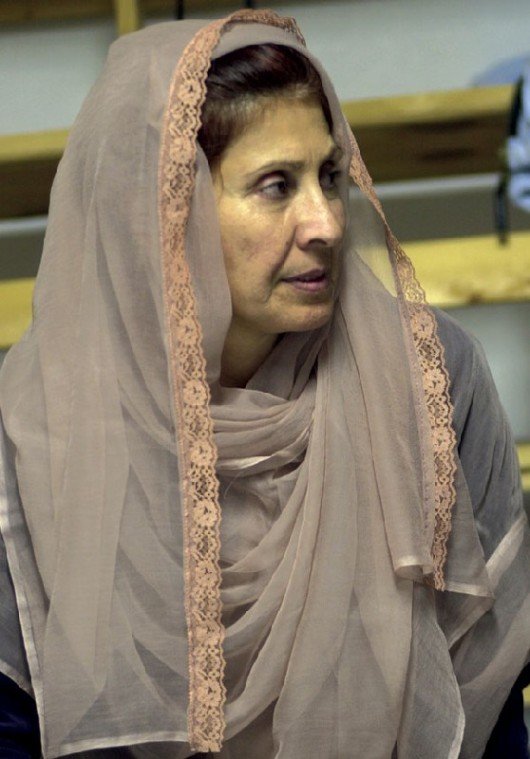Sunset afterglow flooded the western sky as members of South
Valley’s Islamic community started to arrive. A few goats trotted
in their corral next to the simple, one-room building serving as a
temporary mosque, set behind a ranch-style home east of San
Martin.
Sunset afterglow flooded the western sky as members of South Valley’s Islamic community started to arrive. A few goats trotted in their corral next to the simple, one-room building serving as a temporary mosque, set behind a ranch-style home east of San Martin.
On Saturday, Oct. 16 – the second day of Ramadan – Muslims from Hollister, Gilroy, Morgan Hill and San Martin came together for an evening celebration of community prayers and feasting. From sunrise to sunset, they’d all abstained from food and drink in celebration of Ramadan, a holy month, during which, in Islam, God revealed the first verses of the Koran to the prophet Muhammad 1,400 years ago. They will continue to fast for the entire month.
As I took off my shoes and entered the mosque, Hamdy Abbass offered me a platter of dried dates. The sweet fruit is a traditional way to end the day’s fast, the gregarious real estate agent from Hollister told me.
“It’s been a long time since I had a date,” I mused. “A long time.” Abbass and several other men laughed at the corny joke about my romantic life.
A woman with a shawl covering her head introduced herself, and I started to stretch my arm out for a cordial handshake. She politely explained that, to remain ritually pure, women can’t touch men inside the mosque. I had lots to learn about Islam, I quickly realized.
Soon, a man started chanting rhythmically in melodic Arabic. The call was for Maghrib, the sunset prayers. The men gathered in a line in a corner of the mosque, facing Mecca in Saudi Arabia. And, separated by two cubicle walls from the men, Muslim women also lined up. Children and toddlers played nearby.
I watched from the side of the room as they prayed. Between intervals of supplication, periods of somber silence sometimes filled the mosque as worshipers quietly bowed in unison to the floor. Their foreheads touched the carpet in humility to Allah.
Once the sunset prayers finished, the feasting began. On a long table sat large bowls filled with Afghani soup, rice, broiled chicken, breads and spicy vegetables. The men ate separately from the women, everyone sitting on the floor around large plastic tarps.
“One of the great things about Ramadan is that everyone eats at the same time,” Abbass said. “No one eats alone. You invite your friends and family. It’s a whole month of Thanksgiving.”
Indeed, my empty stomach felt truly thankful as I spooned rice into my mouth. From 6:05am to 6:28pm that day, I had eaten and drunk absolutely nothing. The food tasted delicious.
Bakri Musa, a Morgan Hill resident, asked how I felt about my first fast.
“It wasn’t hard for the first six or seven hours,” I told him. “But around one o’clock – man, I was really craving a tuna sandwich. It took a lot of discipline not to open the fridge.”
“The first two days are the hardest,” he said. “After that, you really don’t notice the hunger as much.”
As I finished my plate, Abbass brought me a square of Basbosa, a traditional Ramadan treat made of cracked wheat, sugar and yogurt. As I sampled the baked dessert, I discussed with him and Sharif Razzaqi, the president of the South Valley Islamic Community, the “Five Pillars of Islam” so important to the faith.
The religion’s first and most important tenet, Abbass said, is the declaration of belief in the solitary divinity of Allah: “There is no God but God, and Muhammad is his prophet.”
The second duty is the daily five periods of devoted prayer. The third precept is the required fasting during the month of Ramadan. Charity to the poor is the fourth pillar.
“And number five, if you can make it, is a trip to Mecca,” Abbass said. This pilgrimage to Islam’s holiest city is known as the “Hajj.”
“It’s about universal brotherhood,” Razzaqi explained. “The idea is to get people together. It’s unifying.”
In a framed photograph on the wall, he pointed out the Kaaba – an immense cube-shaped shrine covered with cloth – at the heart of Mecca’s Grand Mosque. Countless Muslim pilgrims in the picture tightly encircled the sacred site.
“Two million people go to the same place, go through the same thing,” Razzaqi said of the Hajj. “Regardless of finance, regardless whether they are white, black … it doesn’t matter. Everybody is the same.”
After everyone finished eating at the South Valley mosque, the floor tarp was cleared and dishes put away. Stomachs now full, people reclined contently along the walls. A microphone was passed for anyone who wished to share their thoughts and feelings about the 30 days of Ramadan.
“Ramadan, what it means,” pondered Morgan Hill resident Mohammed Hussain. “It could mean a lot of things, but one thing in particular is, it reaffirms your religion and makes you reflect on who you are and your purpose in the world. … This is one way we can reflect back on what we are here for – to make this world a better place.”
The microphone next went to Mostafa El Kassed from Morgan Hill. “Ramadan, when I was a little kid, was a time when you don’t eat and don’t drink. And it was a pretty miserable time,” he said with a chuckle. “I didn’t know why people looked forward to it.”
But as El Kassed grew in his faith, he admitted, he started to see the strict fast as a time for spiritual atonement. It provided a way to develop personal self-discipline. “Now I understand what it means. I really look forward to Ramadan when it comes,” he said.
Around 9:30pm, the time arrived for the Taraweekh. A large section of the Quran would now be spoken out loud by Muhammad Asif, an Imam (prayer leader) from San Jose who has memorized the entire Islamic sacred text.
Every day of Ramadan, a portion of the book is recited out loud in its original language.
I listened for the next hour as the mystical sounds of Arabic words filled the room. The chant-like modulations were entrancing. I didn’t understand a bit of what was being said, of course, but I saw it meant something deeply important to the worshipers. Reverence showed on their faces. Women placed cupped hands over their hearts as they listened.
During a short break, Salah Hamed of Morgan Hill told me, “If you know the meaning of what he’s saying, your heart is shaking … When the Quran was first revealed, it was the basis of the religion.”
The Taraweekh finished, the evening’s worship came to an end. Standing by the door as people put on their shoes, Gilroy resident Sarah Sherfy explained to me why Ramadan is such an important part of her faith. She considers the month a good opportunity to make “new resolutions” to strengthen her belief.
“Every year at Ramadan,” she said, “I try to make important changes in my life, in my faith or by helping somebody.”
This spiritual self-discipline helps her to grow.
“People think Islam is very strict,” she said. “But it’s not really. I get a lot out of it … It gives you things you really need. That’s how I feel.”
I left the mosque with a thought that night. If a belief is true, it must first be true in the heart. The South Valley Islamic community certainly demonstrated its true faith of the heart on that second day of Ramadan.
And during this holiest of Islamic months, these devoted Muslims fondly wish from their hearts to all people of South Valley a special greeting:
“Salaam Alaikum – Peace be upon you.”
The story of Islam
The story begins with a man named Muhammad born in Mecca around the year 570.
The boy grew up amid the conflict of the warring people of the Arabian Peninsula. In this harsh desert world, competition for trade routes or a single well of water might ignite a blood feud to last through generations.
At the age of six, Muhammad’s parents died and his uncle took him in. As an orphan, the child learned to feel passionate concern for those left out of society.
Grown up, Muhammad was an intelligent, open-minded man who possessed a powerful charisma.
According to Islam, Muhammad was chosen by Allah (the Arabic word for “God”) to bring to the world an important spiritual message that ignited the Islamic faith. Allah’s oral words to Muhammad would later be written down into a holy book called the Quran. The people who followed this new faith called themselves “Muslims” which means “those who surrender to God.”
The influence of Islam spread quickly, uniting all factions of the Arabian Peninsula. It spread west to Spain and as far east as India during the next two centuries. Part of its appeal was its respect for the dignity of all humans, promoting a peaceful unity and equality of all people.
It was also a religion of ideas. Much of the benefits of civilization the western world enjoys began with the ancient scientists and scholars of Islam. While much of Christian Europe was trapped in the Dark Ages, Islam promoted an enlightened era of technical advances in medicine, engineering, anatomy, mathematics, architecture and astronomy. Islamic mathematicians in Baghdad gave the world the Arabic numeral system as well as algebra and trigonometry. Islamic doctors performed delicate surgery such as removing eye cataracts at a time when Europeans still prayed to the bones of saints for healing.
Today, about 1 billion people around the globe – including about 200 men, women and children in the South Valley – follow the faith of Islam.














